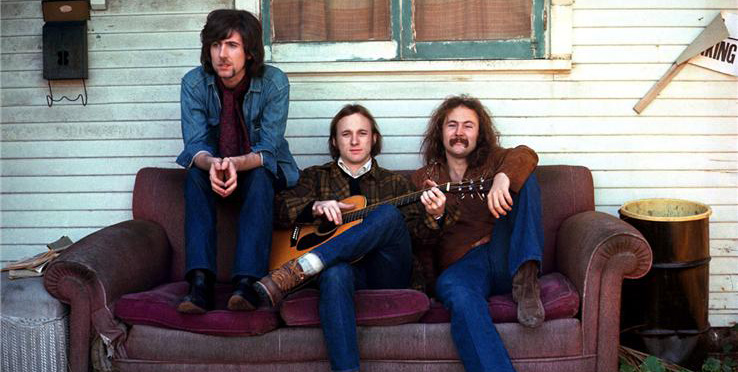Story by Brittney McKenna
Looking back over the last few decades of popular music, there are only a handful of albums that serve as true landmarks, points on a timeline that elucidate our musical lineage and say, “Hey, this is how we got here.” Many of these albums display a marked departure from the artistic norms of their time and, as such, often don’t find commercial success until the rest of the culture has caught up. A few, however, capture the zeitgeist of an era in such a way that everyone is forced to take notice, listen up and follow along.
Crosby, Stills and Nash’s eponymous debut is one of those albums. A gorgeous assemblage of confessional odes, spiritual meanderings and cultural commentary, Crosby, Stills and Nash was an immediate critical and commercial success that brought the music of the late ‘60s to an about-face, grabbing the crown from heavy blues-rock and ushering in the Laurel Canyon sound that would come to define much of the pop music output of the early ‘70s.
One of the original supergroups, CSN easily could have become the living equivalent of a greatest hits record – virtuosic playing from Buffalo Springfield’s Stephen Stills here, thoughtful lyrics from The Byrds’s David Crosby there, with Hollies alum Graham Nash’s ironclad harmonies rounding out the effort – and still found commercial success. Instead, the trio found a way to transcend the sum of its parts, writing one of the greatest folk-rock records of all time and bringing forth a new dawn in songwriter-driven pop music in the process.
Written and recorded before fellow Buffalo Springfield member Neil Young joined the fold and gave the group a bit more “super,” Crosby, Stills and Nash served as the mission statement for a band that, in all its incarnations, would come to leave an indelible mark on what it means to make music in America. Despite serving as the genesis of a storied career spanning nearly fifty years, Crosby, Stills and Nash contains some of the band’s most important songs, including “Suite: Judy Blue Eyes,” “Marrakesh Express” and “Guinnevere.” The musical output of the following years, both from CSN(Y) and artists who followed in their footsteps, like Fleetwood Mac and Jackson Browne, was irrevocably colored by the influence of Crosby, Stills and Nash, a record with so profound a genealogy that the full scope of its impact is yet to be determined.
Looking around in 2014, then, it’s easy to see descendants of the CSN family tree. The pop-Americana resurgence spearheaded, ironically, by British foursome Mumford & Sons shares a number of similarities with CSN’s early output: soaring vocal harmonies; confessional, often spiritual lyrics; and a focus on heavily rhythmic acoustic instrumentation, a style that uses crescendo as punctuation and trades more in emotional currency than it does showy feats of musicianship.
It’s hard to imagine Mumford and all his Sons – The Lumineers, The Civil Wars, even Idol-cum-pop star Phillip Phillips – existing without Crosby, Stills and Nash as their musical north star. Just as CSN found fame at the height of fuzz-drenched guitar psychedelia in the mid to late ‘60s, Mumford & Sons entered the cultural consciousness at the pinnacle of the EDM movement, offering a direct, and apparently welcome, foil to the blips and beeps of electronic music, their debut Sigh No More serving as the album that launched a thousand suspenders.
That said, how would Crosby, Stills and Nash perform were it released today? Musically, it’s rock-solid – forty-five years later and those harmonies are just as revelatory as the day they were recorded. Stephen Stills’s arrangements, replete with unconventional tunings and time signatures, still sound anything but ordinary. David Crosby’s political insights, like those on the RFK-inspired “Long Time Gone,” haven’t lost power to the relevance-stripping force of decades gone by. Graham Nash’s “Pre-Road Downs” would sound at home on Triple A Radio.
Lyrically, the record is strong but can occasionally feel dated, particularly on tracks like Nash contribution “Marrakesh Express,” which, though one of the album’s biggest hits (peaking at #28 on the Billboard Hot 100 Singles Chart) comes off a bit campy in comparison to the rest of the record. “Suite: Judy Blue Eyes” is still one of the most heartbreaking love songs ever written, though the odds of a multi-part, seven minute folk song peaking at #21 on the Billboard Hot 100 Singles Chart (which “Suite: Judy Blue Eyes” did in 1969) in 2014 are slim to none, at best.
We’re likely fortunate, then, that Crosby, Stills and Nash was released before Spotify was a household name. Though the album is, in most regards, timeless, getting to the heart of the record requires full absorption on the part of the listener, a rarity in an age where attention runs short and the thirst for new and shiny has never been more pronounced.
It’s hard to imagine where we’d be had David, Stephen and Graham never sat around singing “You Don’t Have to Cry” in either Joni Mitchell’s living room or Cass Elliott’s dining room (the band still can’t agree on a location). We’d have folk and pop and singer/songwriters, sure, but that musical movement perhaps wouldn’t have come so quickly, or with such ubiquity. It is, after all, such a long time before the dawn, and we can thank Crosby, Stills and Nash for ushering in a new one.
Brittney McKenna is a writer living in Nashville, TN. Her work has appeared in a number of publications, including American Songwriter Magazine, PolicyMic, CMT.com and Relix. For more information, visit brittneymckenna.com

